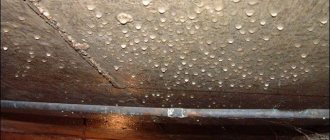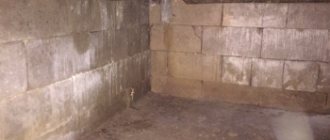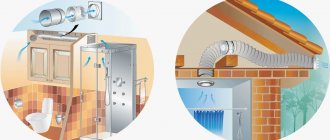Insulation
A relatively inexpensive, but quite effective way to avoid problems with condensation in a garage building is to insulate it. But before starting insulation work, you should remember that when carrying out the work, the type of garage building must be taken into account, which can be carried out in the form of:
- separate capital structure;
- premises built into a residential building;
- in the form of an extension.
In addition to the above options, it can also be a temporary structure, which is a prefabricated structure made from standard sheet metal blanks or a so-called shell garage. When insulating your building, the material used in its construction (metal sheets, brick or concrete blocks) must also be taken into account.
Depending on the above characteristics of the garage structure, a variety of types of insulation can be used to insulate its walls and ceiling, including the following names:
- mineral wool in mats;
- foam blanks or penoplex;
- polyurethane foam or polystyrene foam boards;
- regular backfill made of expanded clay.
Mineral wool
This is how metal garages are insulated with polyurethane foam:
Main factors causing condensation
Installation of a hatch handle in the basement
There may be several reasons for the appearance of condensation in the garage. Moreover, this problem can arise in buildings made of any building material, built at different times of the year and using different technologies. Condensation appears at sub-zero temperatures due to cooling of the outer surface of the building. The inside of the garage remains heated, so drops of moisture appear at the dividing joint. This dividing line is usually the ceiling and walls, so it is on such surfaces that condensation appears.
Why does the humidity level increase in the garage?
- Insufficient ventilation of the room. A well-thought-out air exhaust system from the garage is necessary during the construction stage. Improving or making it later is also not so difficult. Many car owners close the air vents to ensure sufficient heating inside the room, but this should not be done under any circumstances. Insufficient air circulation can even lead to poisoning by harmful substances.
- The insulation of the internal surfaces of the room has not been completed. This is a necessary measure to reduce the difference between the temperature inside and outside. Moreover, we are not talking about cold bridges, but about another concept - dew point.
- Finishing work was carried out incorrectly. The joints between materials must be sealed. If this is not done, you can expect that it is in these places that there will be maximum accumulation of moisture.
A small amount of moisture on the ceiling and walls can be ignored, since such phenomena cannot be completely eliminated. An alarming signal can be stagnant air in the room, as well as damage to metal products inside the room.
Well-organized ventilation is also a safety requirement, because in the garage there are compounds harmful to humans that can lead to poisoning or even suffocation.
Why is dampness dangerous?
The appearance of condensation and a characteristic unpleasant odor are only the first signs of impending trouble. Condensation causes the following consequences:
- mold and mildew appear;
- the temperature and humidity levels in the room are disrupted;
- microorganisms harmful to humans multiply;
- the walls, ceiling and ceilings are constantly waterlogged, which is why the finishing suffers;
- the destruction of the foundation, walls and ceilings begins.
Concrete surfaces and tiles are most often attacked by mold fungi
How to make ventilation with your own hands?
Construction of a garage at the dacha
In order to build ventilation in the garage with your own hands, you need to correctly determine the cause of dampness. Very often, car owners begin to act incorrectly, which only worsens the situation. They believe that only insulation and concreting of the floor should be done, but the existing ventilation holes should simply be sealed tightly. But it is precisely such actions that lead to the fact that condensation begins to appear in double quantities, the atmosphere inside is constantly humid.
This is especially dangerous if the garage is metal; here the walls of the structure are also subject to the negative influence of moisture. All this causes the appearance of toxic fumes, which can be harmful to health.
How to make a damp garage dry? It's very simple, you should first establish the cause.
The first reason is the lack of ventilation. In the garage, you can arrange ventilation with your own hands according to three different schemes:
- Natural ventilation. This type is the simplest and cheapest; moisture leaves the room quite quickly. The principle of operation of such a scheme is the difference in pressure between the outflow and inflow of air and the difference between the temperature outside and inside the garage. You can make such a system with your own hands; you don’t need any special tools or materials for this. It is necessary to make two holes in the wall of the garage for the inflow and outflow of air (the inlet will be located at the bottom, for the outflow - at the top). The method of cutting such holes depends on the material of the walls; their size must correspond to the diameters of the purchased ventilation pipes (polymer pipes are suitable; they are better than steel). The exhaust pipe should rise to a height of about 1.5 m above the surface of the garage, the supply pipe should go slightly at an angle to the ground.
- Forced or mechanical ventilation involves the use of supply and exhaust fans. This must be done as in the first option, only small fans connected to the electrical network are installed at the input and output.
- The combined scheme for ventilation is a combination of the first two methods. But in winter, when such a system is installed, the garage can become very cold, which is extremely undesirable.
Waterproofing. You can also make a damp garage dry by waterproofing the floor, but only if the ventilation holes are working and not clogged and inoperative. Do-it-yourself garage drainage in this way:
- Laying an additional layer of waterproofing (a damp garage is a consequence of improper foundation construction). This is very simple to do: the concrete surface is simply covered with a layer of bitumen mastic, which avoids the penetration of moisture through the floor. The garage drains quite quickly this way.
- Concreting the earthen floor of the garage itself and the inspection pit. If a damp garage has a simple compacted earthen floor, then you will have to make it concrete, that is, to prevent moisture from penetrating inside. Often this procedure must be done for the inspection hole, since excess moisture from there easily penetrates upward. Removing dampness is problematic. In addition to concreting, a forced ventilation system and insulation are often required.
Drying the cellar with a candle
If you don't want to bother with a Dutch oven, there is an easier way to keep your cellar dry and free of moisture. For this you will need a very ordinary candle.
The candle must be placed under the exhaust pipe.
A lit candle placed under the exhaust duct will increase air draft and also help get rid of dampness. Drying the cellar with a candle will take much longer than with a brazier, but if you have nowhere to rush, then you can use this method without any problems.
When using the candle drying method, it is necessary to increase the length of the ventilation pipe (supply pipe if two pipes are used). This should definitely be done. Next, a lit candle is installed directly under the inlet of the exhaust pipe. It is best to place the candle in a small container (for example, a jar).
To give a certain impulse, which will become the beginning of air draft, it is necessary to set fire to a paper sheet in the exhaust pipe. Further, the draft will be supported by the candle flame.
It was already noted above that this is a slow drying method and can be used if you have enough time. All work on drying the cellar is best done a few days before harvesting, so that the room has time to warm up, dry out and get rid of all biological activity. Using a lit candle, you can dry the cellar in 3-4 days. During this time you will have to change several spark plugs.
If the cellar is large, then it will not be possible to get rid of dampness and humidity with a candle.
Preventing dampness
Do-it-yourself bathhouse in the basement of a private house
As usual, this “disease” is easier (and cheaper) to prevent than to treat. Still being decided at the design stage:
- If groundwater is close or its level rises significantly in spring/autumn, external waterproofing is necessary. Liquid compounds are applied to the outside walls (better) or rolled ones are fused (cheaper, but less effective).
- If the cellar is being built on a slope, a drainage pipe must be laid in the ground above it, which will drain the precipitation flowing down the slope.
- A blind area is made around the cellar (or the building under which it is located), which removes precipitation flowing from the roof.
- Inside the cellar, in opposite corners, there must be two ventilation pipes with a diameter of at least 125 mm. One of them ends at floor level - 10 cm higher. Air from the street or room enters through it (supply pipe). The second ends almost at the ceiling - 10 cm below its level. This is a hood. Ventilation pipes on the street should be covered with umbrellas to prevent leaves and precipitation from getting into them. The exhaust pipe (the one that ends near the ceiling) should be higher and it is better to install a deflector on it to activate the draft. It can be painted black: due to heating from the sun, the draft should be better. Another subtlety: for good traction, ventilation ducts with natural air movement must be straight. If it is necessary to make a bend to the side, its angle of inclination must be at least 60° relative to the horizon, and the length of the inclined section should not exceed 100 cm.
- Between the room located above and the basement there should be a vapor barrier that prevents moisture from penetrating both from the basement and into the basement.
Inspecting the floor
Very often the floor in the cellar is made of earth. This is often the source of excess moisture. Through it, the moisture contained in the soil gets inside. To reduce humidity in the cellar, you need to level the earthen floor, compact it and cover it with thick plastic film. You can use roofing felt, but it breaks more often. Although it seems more durable, it breaks due to less elasticity.
There is no need to pour sand or soil on top of the film. Sometimes there is a large amount of water in the basement (accidental flooding). Then you simply remove the film, the water goes partly into the ground, partly evaporates through the ventilation. After the dampness has gone, you can re-cover the floor. If there is earth or sand on top, you will need to poke around in this slurry, extracting the film.
If the floor in the cellar is earthen, most of the moisture enters through it
If after laying the film the humidity level in the cellar has decreased, then you have found the reason. You can leave everything as is, just change the “flooring” periodically, or you can make a concrete floor with full waterproofing. The choice is yours. To prevent the film from tearing when people walk on it, knock down the wooden panels and throw them on the floor.
Improving waterproofing
The second reason why humidity increases in the basement is an insufficient degree of vapor barrier or waterproofing of the walls. This usually occurs if the cellar is lined with brick, especially silicate brick. The material is very hygroscopic and allows water vapor to pass through well. They settle in drops on the ceiling and all objects.
The problem can be solved if you make good external waterproofing: dig out the walls and apply bitumen mastic in two layers. Previously, they were coated with resin, but mastic is more effective and easier to handle.
Brick walls require additional waterproofing
But excavation work is not always a joy, and it’s not always possible to dig out the walls. In this case, you can make internal waterproofing of the cellar walls. For this purpose, there are cement-based impregnations: “Pnetron”, “Kalmatron”, “Hydrotex”, etc. They penetrate to a depth of up to half a meter into the thickness of the material (concrete, brick, etc.) and block the capillaries through which water seeps. Water permeability decreases significantly. Their only drawback is the price. But they are really effective.
All these measures will prevent the appearance of high humidity in the basement. But what to do if there is already moisture, how to dry the cellar? Next, we’ll look at ways to reduce humidity.
Floor work to eliminate dampness
If moisture penetrates the walls, hits the floor and evaporates, you should also address the flooring. The floor and walls should be concreted using liquid glass and roofing felt. You can also follow a simple algorithm (if you have a clay floor):
- remove a layer of clay about 5 cm thick;
- level the floor surface and cover it with two layers of waterproofing film;
- sprinkle it with clay on top or fill it with concrete and level the surface.
Use only cement-based putties, since their gypsum counterparts actively absorb moisture
In case of seasonal flooding of the area, use another method:
- Place a layer of sand or gravel about 10 cm thick on the floor to protect against groundwater flooding. Add more gravel if necessary if groundwater seeps through the drainage layer;
- Apply special waterproofing plaster to the walls;
- Place glass jars with calcium chloride in the corners of the cellar (it will absorb excess moisture). For one cellar no more than 0.5-1 kg of powder is required;
- Sprinkle the floor with quicklime in a 1 cm layer - it will absorb excess moisture and dry the room. To combat fungus and mold, you can slak the lime directly in the basement. Pour some lime into an empty container and fill it with water. The released vapors will destroy germs and mold.
During the release of lime vapors, it is better to leave the room. Return there in an hour and immediately organize ventilation for several hours.
Why does humidity rise in the garage?
Why moisture accumulates inside the garage is a question that does not have a single answer: there may be several reasons for this.
We list the most likely of them:
- It may be damp due to storing fruits or vegetables in the basement, from which moisture appears.
- Melting snow from the wheels of a car that is stored inside.
- Moisture condensation on the car body. This is possible when a warm car drives into a cold garage.
- Raindrops on the car (body).
- Lack of ventilation. The main reason for rising humidity levels. If the room has properly functioning ventilation, then even all of the problems listed above will not lead to dampness.
Why and where does condensation occur?
Condensation can form on the ceiling, on the door/gate (from the inside), on the walls and even on the floor. Often, high humidity is observed in the garage cellar (but condensation does not always form there).
Accumulation of condensation in a brick garage
Moisture will condense on the inner surface in places where the distance between warm and cold air is smallest. If there are no other buildings in the vicinity of your garage, then these will be the walls, ceiling and gate. If the garage is in a row, then drops will appear on the ceiling and on the gate.
The main reason for the formation is the lack of insulation. In most cases, this is the main reason: there is warmer air inside, while outside in winter it is colder. Between them there is only a thin partition (if there is no insulation) made of brick/metal/concrete (depending on what the room is built from), that is, from materials that do not perfectly retain heat.
What are the dangers of increased humidity in the garage?
Dampness can lead to very serious consequences, both for the building itself and for the things stored in it (including a car).
Possible problems:
- Corrosion formations on the body of a stored car. Due to dampness, it may begin to rust: in places where there is no paint, or where it has peeled off/chipped off.
- The appearance of mold. It is dangerous for wood, metal and textile products that will be stored inside, as well as for food (which is often stored in garage basements). Mold is also dangerous for humans, but people usually stay in the garage infrequently and not for long, so the main damage will still be caused to the building itself and the things inside.
- Accelerated destruction of the building. Metal garages suffer the most from this (they begin to rust), but the same problem, although to a lesser extent, is observed in concrete buildings.
- Failure of the gate opening/closing mechanism (which can also rust).
Control measures
To get out of a difficult situation, it is recommended to do the following:
- Do external waterproofing work.
- Make new waterproofing inside the basement.
- Eliminate existing cracks around the perimeter.
- Setting up ventilation.
- Use the express method.
Each method has its own merits. Let's talk about this in more detail.
Harm from mold to humans and buildings
If the owners see mold in the basement of a wooden house, how to get rid of it must be decided immediately, before the problem goes far. After all, fungus can negatively affect the health of all family members, the condition of the basement itself and the house. Mold causes the following damage:
- reduces the service life of finishing and building materials, shelves and racks made of wood;
- affects concrete floors, which begin to crumble and lose strength;
- harmful fungal waste products enter the house or garage if the cellar is located underneath them;
- vegetables and fruits are also affected by mold, the products acquire an unpleasant “aroma” and spoil;
- Mold in the basement also negatively affects human health - its toxins cause headaches, nausea and vomiting, lung diseases, coughs and runny noses, and allergies.
Quick drying using a broiler
You can remove excess air humidity and condensation from the cellar using the simplest fryer. This small (portable) device can be found in almost any country farm. In any case, you can ask your neighbors.
The fryer quickly heats the air in the room.
Before drying the cellar using a roasting pan, it is necessary to partially get rid of excess dampness by natural drying for several days. In this case, the fryer will only “finish off” the remaining dampness, humidity and condensation.
If you have not found a suitable device for drying or a roasting pan, then you can make it yourself from the simplest old bucket.
The drying process itself is as follows:
- Before starting drying, open all the openings that go into the cellar (manhole, ventilation pipes).
- Next, we lower our brazier (bucket) to the bottom of the storage. You can do this yourself or use a rope and hook.
- Light a fire in the brazier. It needs to be maintained for some time until the damp air completely leaves the room.
- According to the laws of physics, warm and dry air from the bottom of the cellar will begin to gradually rise, displacing damp air into open holes. After some time, the cellar will dry completely.
The principle of drying a basement using a roasting pan from an ordinary bucket.
Before drying the cellar using this method, it is necessary to consider some nuances:
- It is recommended to use sawdust and wood chips to light the Dutch oven. Once the fire is hot, you can add larger wood to the roasting pan. It is important that the ignition of the brazier occurs before you lower it to the bottom of the cellar.
- The heat from the fire will quickly warm up the room, removing the damp air outside. In turn, dry air will quickly spread throughout the cellar. It is necessary that the entire room is saturated with smoke. This will get rid of any biological activity in the storage, which also negatively affects the storage of vegetables and fruits. The effect of warming the air in this case will last for a long time.
However, condensation in the cellar does not always disappear immediately after drying, so you need to wait a little and, if necessary, repeat the action, and also check the quality of the ventilation system.
Constant dampness: how to eliminate it
Before choosing a way to deal with dampness in the garage, it is necessary to determine the causes of high humidity. Usually it appears due to the lack of a high-quality ventilation system or due to its improper operation. Ventilation may be faulty due to defects in the construction of the building or due to clogging of the hood.
The cause of high humidity may be poor-quality waterproofing, the presence of an earthen floor or a cellar.
If excessive moisture is not eliminated, the garage owner will suffer from a harmful atmosphere, the structure will become corroded, which will eventually lead to its destruction. To get rid of dampness, you need to establish a ventilation system. Ventilation in a natural way is the simplest and cheapest. It is based on the principle of temperature difference, or more precisely, the difference between the inflow and outflow of air.
How to set up ventilation:
- Buy ventilation pipes. It would be good if the structures were polymer and not steel.
- Equip the wall of the building with two holes. The lower one will let air in, and the lower one will let air out.
- The dimensions of the holes are selected according to the diameter of the pipes.
The mechanical method of ventilation involves the operation of fans. They come in exhaust and supply types. To operate this design you will need an electrical network.
Ventilation arrangement
A poorly ventilated cellar can become damp even in the absence of any other reasons. Therefore, ventilation is a necessary condition for maintaining this indicator at normal levels.
The easiest way to set up a ventilation system is as follows:
- a pipe with a cross-section of at least 20 cm is installed at a height of 10 cm from the floor and led out into a hole under the ceiling so that it rises 35–40 cm above the ground;
- another similar pipe is installed only on top at the other end of the room and brought outside at a height of 50–60 cm;
- the outer ends of both pipes are covered with covers to protect from precipitation.
Related article:
Requirements for keeping quails at home
In such a system, the first pipe will provide an outflow of air, the second will provide an influx of fresh air.
Dehumidifying air using improvised methods
If the air in the garage is damp, and purchasing a dehumidifier is not yet possible, then the following methods can be used as a temporary solution:
- silica gel balls poured into containers and placed in different places in the garage. Some craftsmen pour them into a bottle, and to make the air circulate better, attach a small fan. Silica gel can be dried and reused;
- white moss in powder form, placed in containers around the room, work in the same way as silica gel. It actively absorbs moisture;
- Calcium hydroxide has good absorbing properties;
- Another option is clay brick. It is heated well in the oven and placed in the garage. As the brick cools, it absorbs moisture. For high-quality drainage, you will need several of these bricks, and you must work carefully so as not to get burned;
- some advise using hydrochloric and sulfuric acids, but the possible risk of burns and poisoning is higher than the likely benefits of the methods, so they should not even be considered.
You can check the effectiveness of such improvised dehumidifiers using a hygrometer. The simplest devices cost a penny, but they measure the humidity level quite accurately.
When using these homemade dehumidifiers, remember that a device specifically designed for dehumidification will always work much more efficiently, especially if it is chosen correctly.
Tags:Garage
How to get rid of water in a garage cellar
To quickly get rid of accumulated water in the basement, you need to familiarize yourself with the basic methods of cleaning basements.
Automatic water pumping system
It is not always possible to create a high-quality drainage system in the basement, which is why liquid accumulates in it, which can be eliminated with an automatic pumping system. To make such a device, you need:
- Create a hole in the cellar. First, a recess measuring 55 x 55 centimeters is dug, the walls of which are lined with brick. Then the bottom of the hole is covered ten centimeters with gravel.
- Buy a pump. This is the main element responsible for pumping out liquid. It is installed in a hole, after which hoses are connected to it, which will remove water outside the cellar.
Creation of a drainage system
A drainage system is created to prevent water from accumulating in the garage basement. When creating it, you should take into account the groundwater level and soil characteristics.
The manufacture of drainage is carried out in several successive stages:
- Creating a trench. It is created at a slight slope so that the liquid drains faster.
- Laying geotextiles with crushed stone. Prevents moisture from penetrating into the dug trench.
- Pipe installation. When laying it, make sure that the pipe fits snugly to the bottom of the trench.
- Backfilling with crushed stone. The laid pipe is sprinkled with a layer of crushed stone, which is covered with geotextile on top and covered with soil.
Waterproofing
Another method of protecting a garage cellar from moisture is to create reliable waterproofing. Before starting work, the walls and floor surface of the basement are cleared of debris. They are then treated with a penetrating waterproofing mixture, which will seal microcracks.
After processing, the walls are coated with a layer of mastic and a special iron grating is fixed on them, which is covered with cement mortar and plastered. Then the metal mesh is laid on the floor and also covered with concrete mixture. To make the flooring smooth, you can remove all the unevenness from it and cover it with plywood or any other finishing material.
Installation of external and internal drainage
Installing drainage will help get rid of dampness in the basement. An external drainage system is more economical and effective in preventing moisture. Since in this case, groundwater is discharged behind the garage building - into the sewer system.
However, this method is convenient only for free-standing structures. This means that installing external drainage is not suitable for either garage co-ops or residential basement garages. It is best to worry about the external drainage channel during the construction period.
It is more logical to equip a large basement with an internal drainage system so that it does not get wet. To do this, dig a trench up to 40 cm deep around the perimeter, preferably before building the floor. Then cover it with geoseptic material and cover it with a layer of crushed stone. Next, in a vertical position, plastic tubes are buried in the trench at a slope of 3 mm for each meter, which will receive and drain excess water. To prevent pipes from clogging, they are covered with galvanized grating.
You should focus on ensuring that no runoff gets into the soil, otherwise all efforts to dry the basement will be in vain. To collect water, it is recommended to install a well and install an automatic pump in it to pump out water. Instead of a well, you can use a barrel.
When building a basement, it is recommended to use concrete, monoblocks or reinforced concrete slabs, not only for the cellar floor, but also for the walls. Do not use porous materials such as expanded clay or foam blocks, brick. In practice, basement walls built from these materials are very problematic to waterproof and thereby ensure their proper water resistance.
Chemical treatment
What to do if the utility room is damp, and there are no funds for large-scale waterproofing work? If the room is small and the condensation in the basement is not too large, then white moss powder will be a good help in drying. It has excellent natural absorbent properties and perfectly eliminates moisture in the cellar.
Slaked lime can also help. The container with it is placed in an empty corner of the garage or basement for several days.
Hydrochloric acid is a good helper in the fight against dampness
However, it must be remembered that such a procedure must be carried out with great care. The skin of the hands and face, eyes, and respiratory organs must be reliably protected
The walls and ceiling in the basement are treated with a weak acid solution. After drying, all treated surfaces must be swept and the room itself must be thoroughly ventilated.
The fungus does not tolerate treatment with any acid, so vinegar or citric acid can be used to remove them perfectly.
In some cases, the walls, floor and ceiling are treated with diesel fuel and then whitewashed - after this the basement will become much drier. Of course, the room is thoroughly ventilated after this.
If there are water pipes in the room, then you need to think about timely thermal insulation of such communications, since condensation in the garage can also appear for this reason. There are many different materials available for troubleshooting this type of problem.
Only after making sure that the basement is completely dry can you fill it.
Drying the utility room is an extremely important task for the owner. If timely measures are not taken, the basement may collapse due to excess dampness, wooden structures may deteriorate, and metal structures may rust. All this will have a very negative impact on those things and products that you store in the basement, cellar, or garage.
If the measures you have taken help only temporarily, you should consult a specialist. He will determine exactly why condensation appeared in the cellar and how to get rid of this problem once and for all. He will also help you choose the most appropriate troubleshooting method.
https://youtube.com/watch?v=ZqFBEhR3KfQ
Carrying out preparatory work
The humidity in the cellar is usually at a fairly high level, so condensation forms on the walls and ceiling. Preparatory work includes completely emptying the room of vegetables stored there since last year (they are no longer suitable for consumption, so it is best to remove them from storage).
In addition, it is recommended to temporarily get rid of wooden elements of the room (racks, pallets, various bins, boxes, shelves, etc.). All wooden structures must be taken outside and then washed with hot water and soapy water. They must be completely dry before further use.
Installation of waterproofing for a garage
In many cases, dampness in the garage occurs when there is no concrete floor. If you are building a garage yourself, do not be lazy to fill the floor; damp soil will have a bad effect on the room, and in the end all the work will be done down the drain. After all, the garage will not justify itself, but will bring even more problems.
Therefore, it is necessary to fill the screed with reinforcement. But don’t forget, all this should be done on a bed of gravel and sand.
It must be remembered that the screed does not prevent the appearance of dampness in all cases. Groundwater, which may be close to the base of your garage, interacts well with concrete, and it, in turn, releases the resulting moisture into the room.
Important! Before starting work, find out the groundwater level in the area of your garage. If water is close, be sure to install waterproofing
It happens that a concrete screed is installed simply without waterproofing. There is a solution to this problem: insulate the surface with a self-leveling floor. A thin layer will be enough to prevent moisture from entering the garage.
In concrete garages that are not insulated, moisture can enter through the walls, namely through their base. In this case, you will need a special grease for walls; it is applied to the inside of the wall. Thanks to it, the wall will not become damp. But, do not apply the mixture very close to the floor, the distance from the base of the wall should be 30–40 centimeters, and you need to isolate the joints that are located between the inner wall and the floor.
Modern technology is an effective alternative to natural resources
This method provides good results, but the devices must be used wisely. Thus, in the process of drying walls with an electric dryer, excess moisture loss in certain areas should be prevented. If the walls are already covered with plaster, it is better to put the device aside: sudden removal of moisture will lead to the appearance of cracks on the surface of the wall. In this case, preference should be given to natural drying.
Similar methods of drying a wooden house include an infrared heater and the electroosmosis method. In the latter case, it is better to use the services of a professional.
Use of additional waterproofing of floors and walls
If the reason for the appearance of dampness lies in the proximity of groundwater, then in addition to drying, additional waterproofing is necessary.
Here they use a “clay castle”:
The floor in the premises is covered with a layer of clay and compacted:
- Pour a layer of sand.
- Concrete screed is poured.
How to prevent water from entering through cracks in the floor?
Serious waterproofing of the floor can also be done in this way:
- a layer of crushed stone is poured onto the floor,
- filled with bitumen
- lay a material with waterproofing properties,
- poured with concrete (sometimes expanded clay is mixed into it).
You can carry out additional waterproofing of the walls. To do this, the walls on the inside of the room are covered with insulating material or covered with bitumen.
Internal basement waterproofing
After completing the exterior work, you can also insulate the basement or cellar from the inside. This is done like this:
- dry the room;
- remove all crumbling coatings and whitewash;
- find and clear all cracks;
- saturate the walls with an antifungal agent;
- apply a waterproofing compound;
- if desired, plaster the walls at a height of 0.5-1 m from the floor.
Instead of applying plaster, you can treat the walls with a waterproofing compound
How to deal with humidity after a flooded cellar
Flooding of the cellar can occur due to rising groundwater, penetration of precipitation, or accidental flooding. The reason is not important when it is necessary to decide how to drain the cellar from groundwater or how to dry the basement in the garage from excess moisture. The scheme is simple:
- Use a pump or drainage pump to pump out water from the storage floor.
- Clear out the basement.
- Dry for a couple of days with the hatch open and ventilation.
- Collect trash.
- Whiten with lime.
- Dry the cellar using one of the above methods.
There are settlements where flooding of the basements of private houses and cellars occurs regularly. In this case, it is necessary to strengthen the floor drainage.
External waterproofing of a basement or cellar
Inspect the structure and check the condition of the slopes, drainpipes, drainage system and blind area. If you basically do not have a drainage system, then first start by installing drainpipes and slopes. Next, move on to protecting the external walls:
- remove the old blind area;
- dig a hole about 50 cm wide from the outer wall of the basement;
- dry the outer wall;
- apply an antifungal composition to it;
- coat the wall with bitumen mastic, clay or concrete with liquid glass additives;
- make a blind area from a sheet of roofing material - secure it 0.5 m above the ground level and extend it beyond the edges of the outer wall of the basement;
- fill the hole.
External insulation can be supplemented with a drainage system











